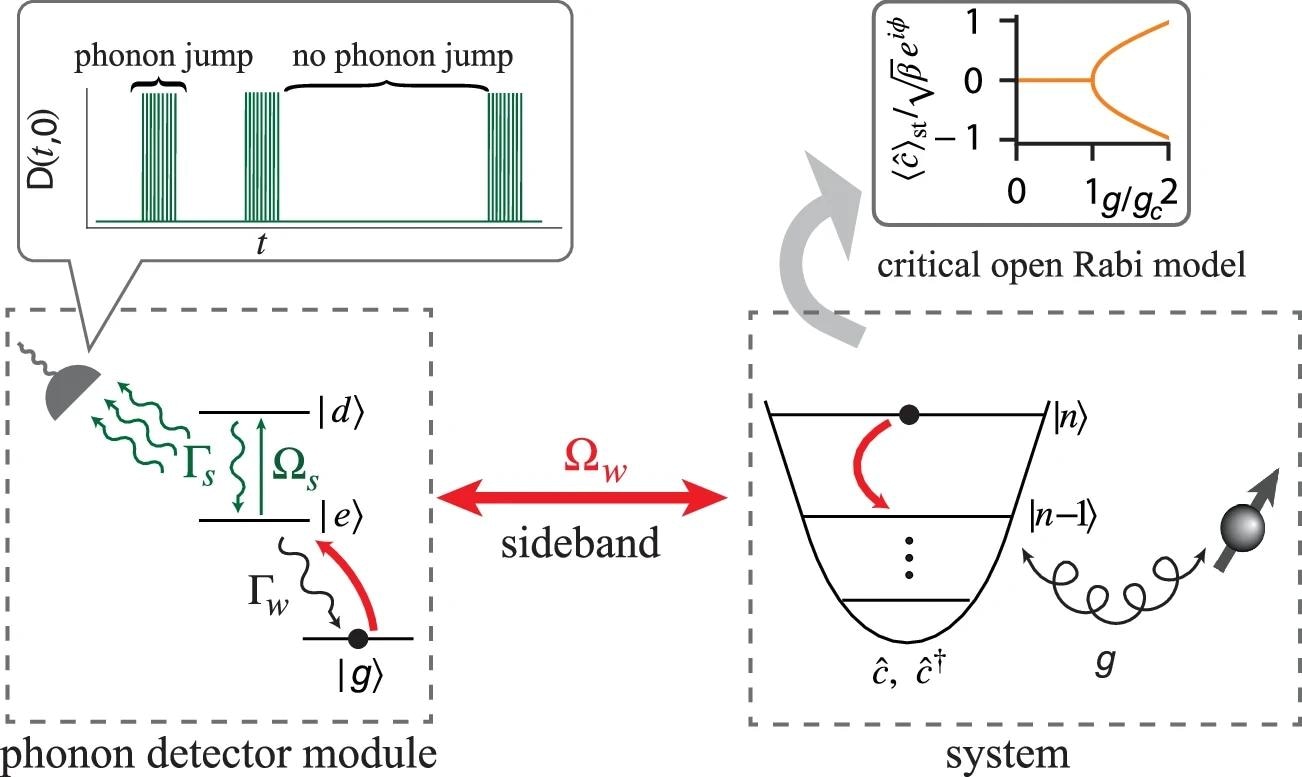 By Nidhi DhullApr 23 2024Reviewed by Susha Cheriyedath, M.Sc.
By Nidhi DhullApr 23 2024Reviewed by Susha Cheriyedath, M.Sc.A recent article in the journal npj Quantum Information introduces an innovative quantum sensor tailored for precise monitoring of oscillating electric field gradients. By leveraging an open Rabi model that incorporates both spin and phonon degrees of freedom of a single trapped ion, the research achieves remarkable sensitivity to electric fields, bolstered by criticality enhancement.
 Schematic illustration of the proposed criticality-enhanced sensor. Image Credit: https://www.nature.com/articles/s41534-024-00833-w
Schematic illustration of the proposed criticality-enhanced sensor. Image Credit: https://www.nature.com/articles/s41534-024-00833-w
Background
In the realm of quantum computing, a closed many-body quantum system becomes highly sensitive to even the most subtle variations in the Hamiltonian parameters, particularly in the vicinity of quantum critical points (CPs). Quantum Fisher information (QFI) measures this sensitivity using a many-body sensor. Conventional quantum sensors have limited precision as they rely on the direct preparation of entangled states and are intrinsically open systems coupled to environmental noise. Thus, researchers are exploring open critical systems undergoing dissipative phase transitions for criticality-enhanced sensing.
Open critical systems are analogous to closed systems at dissipative CPs and continuously exchange radiation quanta with their environment. The constant measurement of the emission field allows sensing of unknown parameters and helps achieve nonclassical precision scaling. The ultimate precision limit of an open sensor for continuous measurements is characterized by the global QFI of the joint sensor and its environment at dissipative CPs.
However, implementing such a sensing protocol requires highly efficient detection of the emission field emanating from engineered critical open systems. The high-finesse optical cavities typically formed to detect this emission field are experimentally challenging. Thus, in the paper, the researchers have proposed a general cavity-free scheme to enable highly efficient monitoring of driven-dissipative open quantum sensors.
Sensing Protocol
The proposed sensing scheme is inspired by entanglement-based spectroscopy and can be considered an extension of the quantum-logic spectroscopy principle for continuous weak measurements. It uses a critical open Rabi model realized with spin and phonons of trapped ions in a Paul trap. Since the trapping frequency represents the electric field gradient at the ion’s location, it is exploited for electric-field imaging and diagnostics.
The researchers successfully implemented the sensing model by utilizing two trapped ions confined in a linear Paul trap, with both ions sharing a phonon mode assumed to be in its ground state. Through the precise manipulation of each ion using focused laser beams, all relevant parameters were experimentally adjusted to finely tune the spin-phonon system to the critical point (CP). Upon annihilation of the phonon mode, multiple photons were emitted, which were then efficiently collected and continuously counted by a photon detector with near-perfect efficiency.
The parameter ω, representing the frequency of the bosonic mode, directly correlated with the actual trapping frequency of the ion. Consequently, ω provided insights into the amplitudes and frequencies of unknown electric field gradients at the ions' location. Moreover, the Fisher Information (FI) derived from the detected signal quantified the precision of ω, thereby determining the precision of the open critical sensor. Monte Carlo methods were employed to numerically compute the FI and conduct finite-size scaling analysis, crucial for assessing the precision-scaling collapse.
While the study focused on utilizing the 171Yb+ ion as an illustrative example for implementing the model, it underscored the versatility of employing various ion species to execute the proposed measurement scheme. Furthermore, the study included a systematic examination of the impact of realistic noise sources, demonstrating the resilience of the proposed sensor setup against experimental noise.
Results
The study successfully realized the parameter ω of the Rabi model as the differential detuning of the laser beams, which is directly related to the trapping frequency. The effective continuous monitoring of electric field gradients was possible via a co-trapped ancilla ion switching between dark and bright internal states conditioned on a ‘jump’ of the phonon population. Despite a low photon collection efficiency, the sensor achieved nearly perfect phonon counting.
By harnessing dissipative criticality and implementing efficient continuous readout, the electric field sensor showcased criticality-enhanced nonclassical precision scaling beyond the standard quantum limit. Furthermore, the ability to sense the trapping frequency of the Paul trap facilitated criticality-enhanced precision scaling, even in the presence of imperfect detection efficiency and in mitigating the effects of realistic noise and imperfections.
Conclusion
Overall, the study implemented a critical open Rabi model based on a coupled boson-qubit system. An efficient phonon detector module monitored the quanta emitted into the bosonic mode. Using a co-trapped ancillary ion as a detection module allowed highly efficient continuous monitoring (e.g., phonon counting) of the critical sensor. It can be used for continuously measuring complex and interacting synthetic many-body quantum systems.
Apart from the direct connection of trapping frequency with electric field gradients, this sensing scheme could also be used to measure other physical parameters like the electrode potential. The researchers endorse the efficient applicability of the sensor to detect experimental imperfections (imperfect photon detection and various sources of experimental noise) in real-world applications. It can also be used to build next-generation ultra-precise sensors for electric-field imaging and noise diagnosing near metallic surfaces.
Journal Reference
Ilias, T., Yang, D., Huelga, S. F., & Plenio, M. B. (2024). Criticality-enhanced electric field gradient sensor with single trapped ions. npj Quantum Information, 10(1). https://doi.org/10.1038/s41534-024-00833-w, https://www.nature.com/articles/s41534-024-00833-w
Disclaimer: The views expressed here are those of the author expressed in their private capacity and do not necessarily represent the views of AZoM.com Limited T/A AZoNetwork the owner and operator of this website. This disclaimer forms part of the Terms and conditions of use of this website.